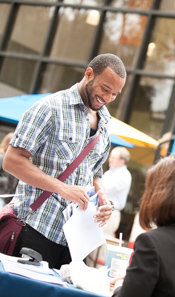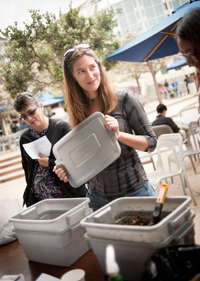Campus Shows Its Green Side for Earth Week
Ioana Patringenaru and Kristin Luciani | April 25, 2011
They planted trees. They learned how to compost. They found out about the many fair trade offerings at UC San Diego. Many members of the campus community turned out for Earth Week celebrations all over campus last week.
Organizers are encouraging students, faculty and staff members to own their impact on the environment, said Kristin Hansen, a sustainability analyst and one of the week’s key organizers. She said she also hopes that members of the UCSD community realize that they don’t have to make dramatic changes to their lifestyle to be green. Simple steps taken every day can have a big impact, Hansen said.
She also encouraged Earth Week participants to talk to their friends and neighbors about what they’re doing to help the environment. Outreach is key, she said.
“Our resources are precious and limited,” she said. “If we don’t care for them, they’ll be gone.”
“Hopefully, it’s a seed that will be planted and continue to grow,” she added.
Planting trees
Thursday, a group of UCSD students and staff members decided to take one such small step by planting sycamore trees along Gilman Drive, just east of Sixth College’s Matthews Apartments. Khristina Hernandez, a senior at Warren College and environmental engineering major, said she has wanted to honor the tradition of planting a tree on Earth Day. “It’s fun,” she said. “And we’re doing it for a good cause.”

Rance Leslie, a Muir senior, and urban studies and planning major, during a green jobs networking fair.
The trees provide a wide range of benefits for the environment, said Sam Oludunfe, UCSD’s urban forester. As they grow, they will provide a sound buffer against noise pollution coming from the 805 freeway. They also sequester C02, which helps combat climate change. The trees also intercept rainwater and remove pollution from the environment.
Planting trees doesn’t just help the campus, Oludunfe said. It also benefits the San Diego community and the region as a whole. “The campus isn’t confined to a box,” he said. “We have an open atmosphere.” Sycamores can live hundreds of years and will continue providing benefits for coming generations, he said. “You’re planting trees for yourself and for the next generation,” Olundunfe told students and staff members gathered along Gilman Drive. “You should be proud of yourselves.”
He and Hernandez then rolled up their sleeves, donned gloves and armed themselves with shovels to plant the first sycamore of the day. They first dug a hole big enough for the tree’s root ball, Oludunfe explained. He then gently tapped a pot where a sycamore sapling stood and extracted the small tree, roots, earth and all. Then he and Hernandez made sure there weren’t any air pockets between the tree root ball and the side of the hole.
“Every single tree counts,” Oludunfe said.
Learning to compost
Tuesday, another small group of staff members and students learned how to make compost to feed trees like the ones Oludunfe helped plant—or backyard garden vegetables. The key to successful composting? Redworms, said Laura McIntire, a yoga and composting instructor with UCSD Recreation. A pound of redworms can eat as much as half a pound of food scraps a day, she added. “These are not your average garden worms,” she said.

UCSD instructor Laura McIntire shows how to set up a worm bin.
During a workshop held at the Price Center, McIntire demonstrated how to create a small worm composting bin that students can use in their dorms and staff members in their office. The ingredients for a successful worm bin are simple, McIntire said: two nesting soft plastic containers, shredded paper and coffee grounds.
First, drill holes on the bottom and sides of the first bin and nestle it on top of the second bin. Then throw in shredded paper and mix with coffee grounds. Make sure the grounds aren’t warm. Worms don’t like it, she said. The worms’ bedding should be about 75 percent shredded paper and 25 percent coffee grounds, she said.
Finally, move in the worms. She gets her redworms from a giant composting bin that can be found behind Outback Adventures here on campus. But they can also be bought from farmers and growers.
Next, start feeding your worms. They’ll eat fruit and vegetable scraps. But make sure you don’t give them any meat, cheese, citrus, garlic, onion, scallions or oil. Also, avoid seeds: the worms won’t eat them and they’ll sprout. Don’t overfeed your worms, either. Oh, and don’t forget to close the lid. Compost should be ready to harvest within six months to a year.
“This is a good way that someone can make a difference on their own,” McIntire said.
Laurel Dean, a staff member with UCSD Recreation, said she has installed a small worm bin in her office’s kitchen. About 10 staff members now recycle their food scraps and their coffee grounds. “We’ve got them all dialed in,” she said.
Chao Wang, a junior at Muir College and math major, said she was afraid of worms. But she added she was willing to overcome her fears to contribute to the health of the environment. Tuesday, Wang won a free composting bin—worms and all—at the end of the workshop. She’s taking it to her boyfriend’s mother house, she said. There’s a vegetable garden that needs compost there.
Learning about fair trade

Mark Chen, a researcher at the School of Medicine, cheers before a free breakfast for bicyclists.
UCSD’s Earth Week celebration continued Wednesday with a Fair Trade Expo showcasing sustainable food practices on campus and in the San Diego community. The expo featured locally grown produce, vegan samples, fair trade tea, coffee and chocolate, as well as current student sustainability initiatives.
Fair trade aims to help producers in developing countries by advocating for prices that support a living wage, as well as better working conditions and environmental standards. The Food Justice movement promotes locally grown, healthy food for the well-being of communities and the environment.
“UC San Diego is considered one of the nation’s strongest fair trade universities,” said Jessica Baltmanas, the student sustainability coordinator for University Centers. “We’ve come a long way, but there is still much to be done. Our goal for today’s expo is to connect food vendors on campus with sustainable food suppliers in San Diego, showing that sustainability is a viable business option for our vendors.”
Participants included Housing, Dining and Hospitality, several of the Price Center vendors and local San Diego producers such as Sage Mountain Farm. Additionally, several student organizations attended the expo to demonstrate the campus’ ongoing sustainability efforts. The Sustainable Food Project, which runs the Pepper Canyon Farm located in Sixth College, and Earl’s Garden, the newest community garden on campus, provided information about sustainable gardening and farming.
“It’s a nice change from the city, even though it’s still on campus,” said Andrew Talbert, a student volunteer at the Pepper Canyon Farm. “And it’s just fun to work in the dirt!”

|